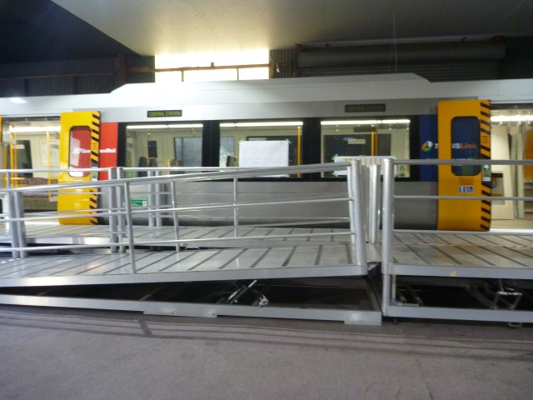Patricia Flores, Queensland State Manager and Senior Access Consultant with Architecture & Access, has been involved in many major key transport infrastructure projects in Queensland providing essential access advice.
Why was this trial important?
Almost one in five Australians live with a disability with the majority reporting a physical condition. Together with rabid urbanisation and ageing population growth, designing an urban built environment (including transportation system) to be supportive and physically accessible requires that city planning must directly respond to the rapid growth and diversity of need within the population. Without these accessible built environments, people with disabilities are more likely to be excluded from services and social contact (World Health Organisation).
As the design of the unisex accessible extended toilet module on the train is required to meet compliance with the Disability Standards for Accessible Public Transport (2002) (DSAPT), which is based on building legislation, the functional trial was important to gain an understanding of how people with a disability of differing ages, specifically public transport users, using different types of mobility devices could independently use this facility. The trial provided a method to observe and assess the person and environment interaction to determine the toilet modules functionality.
What was the objective of the Department of Transport and Main Roads in conducting this trial and what involvement did Architecture & Access have in the trial?
The primary objective of the trial was to determine functional compliance of a proposed new design of a unisex accessible toilet module on NGR trains in South East Queensland specifically in relation to DSAPT Part 15.4 (1) (a) Toilets as outlined below. Architecture & Access, in consultation with Department of Transport and Main Roads, recommended that in order to achieve DSAPT compliance, a trial of the proposed new design was required. Griffith University Hopkins Centre was approached and consequently engaged to design the study, recruit the participants and conduct the trial.
DSAPT requirements for Part 15.4 Toilet 1(b):
1) An
accessible toilet must:
(b) allow passengers in wheelchairs or mobility aids to
enter, position their aids and exit.
Architecture & Access was involved in reviewing the study design, auditing and assessing the unisex accessible toilet module extended design mock-up to be used in the trial, observing the process and reviewing the final report that resulted in the ultimate outcome of achieving DSAPT compliance.
How was the trial conducted? Were there actual participants engaged to be part of the trial?
A mock-up of the proposed extended design of the unisex accessible toilet module was built and people with a disability who use a mobility aid and their carers who live in the Brisbane community, were invited to participate in the trial. Thirty-four participants with mobility aids and seven carers consented to the trial. The mobility aids of the participants measured within the dimensional requirements of the DSAPT footprint, 800mm x 1300mm and did not exceed 300kgs.
Can you explain how your Access Consulting expertise was able to contribute to the trial?
As an access consultant and an occupational therapist, I was able to review and audit the current design and the proposed extended design of the unisex accessible toilet module with reference to the DSAPT. It was clear from the physical and desktop audits, and the lack of prescriptive circulation requirements in the DSAPT to be able to move within the space and perform the task necessary to use the toilet facility independently, that a different type of assessment was required. This, coupled with the restricted space on the train, made it challenging to accurately assess compliance. Observing people with disabilities using different types of mobility aids would provide us with a better understanding if this functional requirement outlined in the DSAPT could possibly be met within this space.
Were there notable Access outcomes from the trial and if so, as a result of the trial will there be new unisex toilets installed in the new generation rolling stock?
The outcomes of the trial indicated that the vast majority were observed to have ‘No Difficulty’ across the ten functional use areas assessed. The trial also gathered information about personal preferences in relation to functional use as well as establish end-user comfort, perceived safety and ease of use of the proposed module.
Architecture & Access concluded that the proposed new extended toilet module design would meet the below requirements.
DSAPT requirements for Part 15.4 Toilet 1(b):
1) An
accessible toilet must:
(b) allow passengers in wheelchairs or mobility aids to
enter, position their aids and exit.
Based on these results this proposed unisex accessible extended module toilet design will be rolled out on all the NGR trains and will inform any future rollingstock toilet designs undertaken by the Queensland Government.
